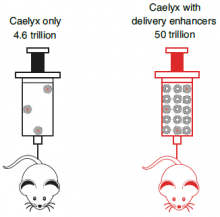BACKGROUND
The delivery of nanoparticles into solid tumours is critical to their utility for diagnosing and treating cancer. Yet only 0.7% of nanoparticles successfully localize to solid tumours largely due to clearance by the reticuloendothelial system (RES), resulting in poor clinical translation of nanomedicines. Though various solutions have been proposed; modifying various physicochemical properties of nanoparticles such as size, shape, and surface chemistry, or using biological techniques such as ablating or saturating Kupffer cells, these have only resulted in minor increases in delivery. Furthermore, another challenge is that none of these approaches present a central and systematic principle for improving delivery efficiency.
TECHNOLOGY
Researchers at the University of Toronto have demonstrated an approach to increase the efficiency of nanoparticle delivery to tumours. Called AIDE (Artificially Increasing Dose for Efficacy), it involves simultaneously administering a mixture of nanoparticle carrier vehicles loaded with an active ingredient (therapeutic nanoparticles), with nanoparticle carrier vehicles without the active ingredient (decoy nanoparticles) (Figure 1). The purpose of the latter is to overwhelm the RES, which enables enhanced uptake of the therapeutic nanoparticles at the tumour site. They have tested their method of nanoparticle dosing using the cytotoxic nanoparticle Caelyx/Doxil and determined that a threshold above ~ 1.5 quadrillion nanoparticles likely ensures efficient drug delivery in humans.
Figure 1. Illustration of nanoparticle delivery using AIDE. Injections of therapeutic nanoparticles (Caelxy, red/gray circles) by themselves are largely taken up by the RES. Co-injection with decoy nanoparticles (no active ingredient, gray circles) as delivery enhancers lead to significantly larger uptake in tumours.
COMPETITIVE ADVANTAGE
- Reproducible delivery of high quantities of nanoparticles to tumours
- Upto 12% tumour delivery efficiency
- More efficacious treatment of cancer
- 57% smaller tumours and 29% longer survival in 4T1 tumour-bearing mice
APPLICATIONS
- Drug delivery in oncology
- Delivery of nanoparticles (gold, silica, nanogel or polymeric nanoparticles; micelles) to tumours for other purposes (e.g. imaging)
INTELLECTUAL PROPERTY STATUS
- Patent Applications: US, CA
PROJECT STATUS
Proof-of-concept studies have been conducted in mice. Enhanced accumulation of nanoparticles in tumour tissue and decreased accumulation in the liver have been demonstrated in 4 different mouse models of cancer using AIDE. Increased cancer drug potency was demonstrated using Caelyx/Doxil/liposomes (Figure 2). Doxorubicin accumulation in tumour cells was higher using AIDE, leading to tumours that were 57% smaller and increasing mice survival by 29%. AIDE was also not observed to cause acute (2 day), subacute (2 week), or chronic (1.4 yr) toxicity to the liver, heart or blood.
Figure 2. Therapeutic efficacy of Caelyx with and without AIDE. Tumour volume significantly decreased (left) when using Caelyx with deliver enhancers, compared to Caelyx alone, or controls (gray). Survival significantly increased (right) in 4-T1 tumour bearing mice upon using Caely with delivery enhancers.





